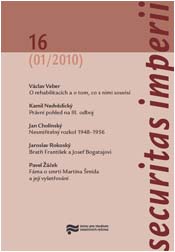O rehabilitacích a o tom, co s nimi souvisí
Rehabilitations and related issues
Author(s): Václav VeberSubject(s): Law, Constitution, Jurisprudence, Criminal Law, Security and defense, History of Communism
Published by: Ústav pro studium totalitních režimů
Keywords: political rehabilitations; communism; Czechoslovakia
Summary/Abstract: Rehabilitations were an important phenomenon of communist power. They were the reverse side of communist persecution and the illegal means and methods that were primarily used by the State Security services (StB) during interrogations and by prosecutors and courts while condemning opponents of communism. This manifested itself in the communist movement in connection with the acknowledgement of communist crimes which, in general terms, occurred after Stalin’s death. It was necessary, at least in the eyes of communist leaders, to restore communism’s credibility. At first, rehabilitation involved re-examination the political trials of communists. (In this country, 278 communists had been convicted in the first half of the 1950s.) For this purpose, the leadership of the Czechoslovak Communist Party established four special rehabilitation committees – the Barák Committee, the Kolder Committee, the Barnabite Committee (initially chaired by Josef Lenárt and subsequently led by Vladimír Koucký) the Piller Committee and the final Kempný Comittee (which did not investigate anything but just formally ended the rehabilitation process). Not one of these committees dealt with the rehabilitation of non-communists. 23,306 citizens applied for rehabilitation in connection with the adoption of a rehabilitation law in April 1968 which was in operation for only a short time. The rehabilitation laws of 1990, 1991 and 1992 subsequently enabled 195,612 citizens to become rehabilitated on the basis of their applications or applications made by family members of those who were to be rehabilitated. Rehabilitation is an important topic for research into anti-communist resistance. Because the accused naturally made an effort during investigations to deny their anticommunist activity, they tried to emphasise this aspect of their actions even further before rehabilitation panels during the era of communist government. This widespread and understandable effort to downplay the matter even gave rise to the impression that the anti-communist resistance did not become a large scale movement and was provoked to a large extent by the activities of the StB, who sought justification for harsh punishments (including capital punishment) and who also wanted to justify the need for their existence to the regime. Researchers of anti-communist resistance must take account of these factors in their work.
Journal: Securitas imperii
- Issue Year: 2010
- Issue No: 16
- Page Range: 10-29
- Page Count: 20
- Language: Czech

